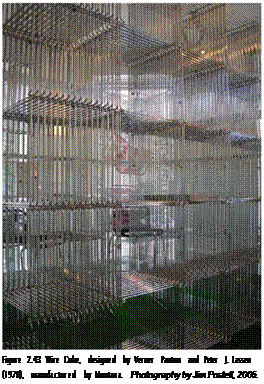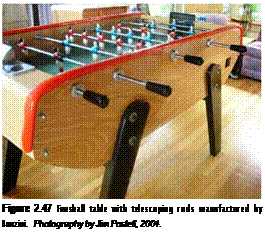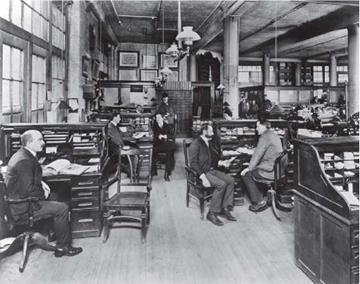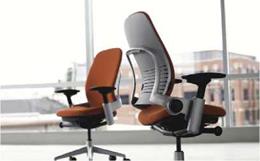Office furniture constitutes a large segment of the furniture industry. The U. S. office furniture industry has grown significantly over the past 20 years, reaching $12 billion in gross sales in 2006.7 Ergonomic seating is a large portion of this market. Today, many well-designed ergonomic chairs are available. Some of these include Haworth’s Zody, Herman Miller’s Equa, Aeron, and Mirra chairs, Humanscale’s Freedom chair, Knoll’s Chadwick™ and Life® chair, and Steelcase’s Leap chair (Figure 2.44).
Office furniture systems have undergone significant transformations because of social and economic change, ergonomic theories, and technological innovation. From the metal and wood chairs that were first introduced in the mid-1800s to the intuitive mechanisms and polymer fibers of today’s ergonomic seating, office furniture has significantly transformed. Consider how computer and digital technology, new production advancements, and cultural shifts in the way office work is organized and managed have changed the workplace from the heavy, dark environments that were typical 100 years ago (Figure 2.45).
 In 1968, Herman Miller introduced Action Office (see Chapter 4), the first panel-based, open-plan office system in the world.8 The designer, Robert Propst, developed a system of components that could be configured and reconfigured as needed over time. The ability of individuals to control their physical and ambient work environments responded to a growing trend. The Action Office system
In 1968, Herman Miller introduced Action Office (see Chapter 4), the first panel-based, open-plan office system in the world.8 The designer, Robert Propst, developed a system of components that could be configured and reconfigured as needed over time. The ability of individuals to control their physical and ambient work environments responded to a growing trend. The Action Office system
|
|
|

 transformed the workplace, as well as Herman Miller and the entire furniture industry, into a systems-based approach in thinking about the role of design.9 Since then, the concepts of networking, teaming, and hoteling have developed in the culture of the workplace, and these in turn have inspired new office systems and new product lines. Primary themes behind Action Office are open communication areas, flexibility for spatial and functional change, maximizing the utility of vertical surfaces, and incorporating a greater sense of user control throughout the workspace.
transformed the workplace, as well as Herman Miller and the entire furniture industry, into a systems-based approach in thinking about the role of design.9 Since then, the concepts of networking, teaming, and hoteling have developed in the culture of the workplace, and these in turn have inspired new office systems and new product lines. Primary themes behind Action Office are open communication areas, flexibility for spatial and functional change, maximizing the utility of vertical surfaces, and incorporating a greater sense of user control throughout the workspace.
Nearly 35 years later, Ayse Birsel’s Resolve office system (Figure 2.46) reestablished the success of Herman Miller’s original office system by expressing new ideas about spatial flexibility and individual control over one’s environment. Resolve utilizes geometries based upon 120-degree angles that create inviting, attractive, space-efficient, and open workstations. The system is composed of vertical poles of various heights and tiered support trusses that manage power and define space. The shape and size of the horizontal work surfaces, used for writing and working, can best be described by extending one’s arm out in front and sweeping it from side to side. It has high recycle content and offers supporting products that include canopies, specialized work surfaces, and lighting fixtures.





